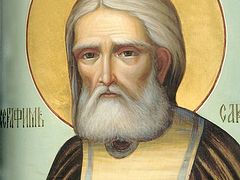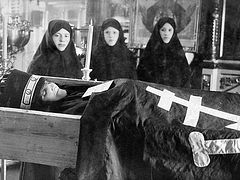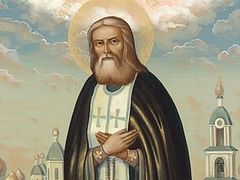The place name Diveyevo comes from the Russian root word, “divo,” or wondrous. As St. Seraphim said, “When my relics will return Diveyevo, that will be the wonder of wonders.” Through the prayers of our holy father Seraphim, may this project succeed—a may it also be translated into English!
 The St. Seraphim-Diveyevo Convent.
The St. Seraphim-Diveyevo Convent.
To discover a monastery in mature age is often a heroic deed and a miracle. And sometimes, the story of one’s acquaintance with a holy place can grow from a casual event into the main work of one’s life—the work not only of one person, but of the whole country [even beyond].
All together
After his first visit to Diveyevo, the director Andrei Kholenko1 got enthusiastic about the idea of making a documentary on the convent. Remembering his personal impressions and the circumstances of his acquaintance with the Diveyevo Convent, Andrei resolved not to invent anything new and to call his project by the name so familiar to every Orthodox Christian: “Wondrous Diveyevo”.
“Because this site is truly marvelous and wondrous, and these are the right words to describe it: the St. Seraphim-Diveyevo Convent is associated precisely with these words for thousands of believers. The Mother of God and Father Seraphim (that is, St. Seraphim of Sarov) lead each of them there by various and always miraculous ways,” says the director.
The documentary has been shot for one year and several more months are left. Now the “Wondrous Diveyevo” project has become national: now it is a public project and everyone can make his or her contribution to the creation of the film by becoming a participant in the project on the website http://www.diveevo.tv.
The film’s release is scheduled for August 2016. All copies of the documentary—1000 DVDs—will be donated to the St. Seraphim-Diveyevo Convent.
Recently the successful Russian animation on faith, hope and love, The Wonderful Adventures of Seraphima, was viewed by hundreds of thousands of people. Its makers visited Diveyevo and consulted with the nuns regarding the shooting: each of them had a unique and personal story related to the convent and Father Seraphim. The makers of the first film on the St. Seraphim-Diveyevo Convent had a similar story.
“In order to express the beauty of Diveyevo, you need to shoot, shoot and shoot”
 A bird’s-eye view of the St. Seraphim-Diveyevo Convent.
A bird’s-eye view of the St. Seraphim-Diveyevo Convent.
—Andrei, when was your first visit to the fourth abode of the Mother of God (that is, Diveyevo according to tradition)?
-—It took some time before the convent became “Wondrous Diveyevo” for me. I was shooting a documentary in Vladivostok on more than a hundred years of history of one of the city’s largest bread-baking enterprises. During the filming I learned that from 2002 on, the bakery workers made a pilgrimage to Diveyevo every year on Holy Saturday, the day before Easter. There they worked, prayed, took holy water from the St. Seraphim’s well, brought it to Vladivostok and used it to knead the dough for Easter cakes that were then bought up by the city residents. I was so amazed at this fact that I decided to go to Diveyevo myself.
—And how did it come about that you came to the convent as an ordinary pilgrim but ended up the director of the first documentary on Diveyevo?
—Surprisingly, no serious film has ever been made on the fourth abode of the Mother of God. I arrived at Diveyevo among other pilgrims, but in the line of my profession I happened to meet one nun whose obedience was to work with media.
She complained that many people were coming to the convent to shoot films and programs, but none ever made a film on the convent itself. There was no film which would relate the convent’s history, show the its modern life, and simply the beauty of Diveyevo, with no dramatic stretches or quest for some weird and much-talked-of “mystery” of Diveyevo.
So my colleague, producer Alena Shmakova, said without a second thought: “No problem at all! Andrei will make you a documentary! For free.” The nun exclaimed: “What! Will he really?” And I confirmed: “Surely!” This is how the story began.
But even before that conversation I had been so captivated by the beauty and peace of Diveyevo that I was filled with a desire to share this wonder with my friends and colleagues. Soon after that we went on our first film expedition.
 The St. Seraphim-Diveyevo Convent at night.
The St. Seraphim-Diveyevo Convent at night.
—How much time had you spent near the convent before you started shooting? How often did you go to Diveyevo?
—To tell the truth, it was my first conscious visit to the convent. And that visit became quite an event for me. I came in the summer for a week. There I fasted, prayed and filmed. And then I realized that a week-long stay there was not enough at all. In order to show all the beauty of Diveyevo you need to film the different seasons: summer, autumn, winter and spring. And the period when apple-trees round the cathedral are in full bloom, and the feast of Dormition of the Mother of God—then the Holy Canal of the Mother of God is decorated with flowers in its full length. And this is 775 meters (c.0.48 mile) long! It is, truly, the outward side, but it is essential in filming too.
—Who joined you and became a part of the film crew? We heard there was another miracle here.
—Like-minded colleagues of mine instantly joined me. We noticed that there were very successful online fundraisers, so-called crowdfunding. We thought a little and decided that we ought to involve as many people as possible in raising the necessary funds to complete the filming of the Wondrous Diveyevo documentary. I should stress that our film is a common effort to help the St. Seraphim-Diveyevo Convent.
As for miracles, truly they are occurring in the Diveyevo Convent all the time. During one of my first visits, the nun whose obedience was work with press and publishing activities said, “There have been so many camera operators in the convent. But long ago, some ten years before your arrival, there came one operator who made plenty of extremely beautiful shots in the convent!” As it happened, she was talking about one young lady operator. I asked for her contact information but the nun said she had not seen her since then. However the nun did tell me her name—Yulia Galochkina. And that was all.
I found Yulia Galochkina through the internet. I introduced myself to her and said that I was making a documentary on Diveyevo Convent and that nun M. sends her best regards. The young lady replied, “Yes, that’s me! But I am currently in Hawaii.”
I was almost frustrated. But the lady went on, “I will be back in Russia; then we will be able to meet and talk about it in more detail.”
Exactly a month after my conversation with the nun, Yulia Galochkina and I came together to the convent. Nun M. met us and exclaimed, “But it is a miracle—a Diveyevo miracle!” This is how we found a photography director for our project.
—Who is the main character in your documentary?
—The St. Seraphim-Diveyevo Convent. For many people this is their most precious place. Here you will hear many stories of miracles. Cases of miracles are recorded in a special book. But we are not filming material about miracles yet—several separate films should be devoted to them (laughs).
Our task is to do it with maximum quality cinematography in order to show the beauty and extraordinary spirit of Diveyevo without, interviews. So, we ought to summon up patience so as to film, film and film some more.
The famous English film director Sir Alfred Hitchcock, when asked concerning the difference between a documentary film and a live-action movie, answered, “In a live-action movie the director is god. But in a documentary God is the director.”
And I am obliged to follow Him. How the Lord will provide, how He will “direct”—such will be the film.
—Are you using up-to-date equipment in your project?
—Yes, we have to do this in order to convey the beauty (smiles). First of all, this documentary is designed for those who have never been to Diveyevo. We shoot from different angles, including from the air. Modern equipment allows this. We have taken a multirotor (also known as drone) with us—a helicopter with a camera display. It is run by a pilot, while an operator or a director is standing near, giving commands. Using this machine we have made the following scene: the helicopter flies round the convent at night, and then the night turns into morning and day. Beautiful!
—In order to attract attention to the project you have used an uncommon technique—“the quick march.” Can you tell us about it in more detail?
—As they say, “a sound mind in a sound body.” So, for me “a sound body” is running, and “sound mind” is the Orthodox faith. I had the occasion to run through all inhabited localities on the highway between Murom and Diveyevo late in September 2015. I ran alone, wearing a T-shirt with the text, “Wondrous Diveyevo! Join the project!” I ran about 20 kilometers (c.12.4 miles) that day. Journalists interviewed me several times along the way.
—Have any miracles occurred to you or your relatives during the period of filming?
—Yes. For example, I have become a grandfather. Isn’t it a miracle?! I must say my daughter suffered from problems in her pregnancy. She used to call me by mobile phone while I was working in the convent. I used to say to her, “If you want, send me a request in your mind, and I will pray to St. Seraphim of Sarov—he will definitely fulfill it.” And she gave birth to a sound, quiet boy, to the joy of all our family.
—What are your plans for the future?
—I want our first documentary on Diveyevo to open a whole series of films which would help people find answers to important questions in life. People always wish to be happy, but in our modern difficult age of information it is so easy to lose your way and go astray—because a lie has learned to disguise itself as the truth. During my filming in the Diveyevo Convent I noticed that most of the pilgrims were young, beautiful people with spiritual faces. And this gives me the right to hope. Because, being in contact with such holy places as the St. Seraphim-Diveyevo Convent, people begin to see themselves, their neighbors and the world around them in a new light.
Trailer for the Wondrous Diveyevo film.







